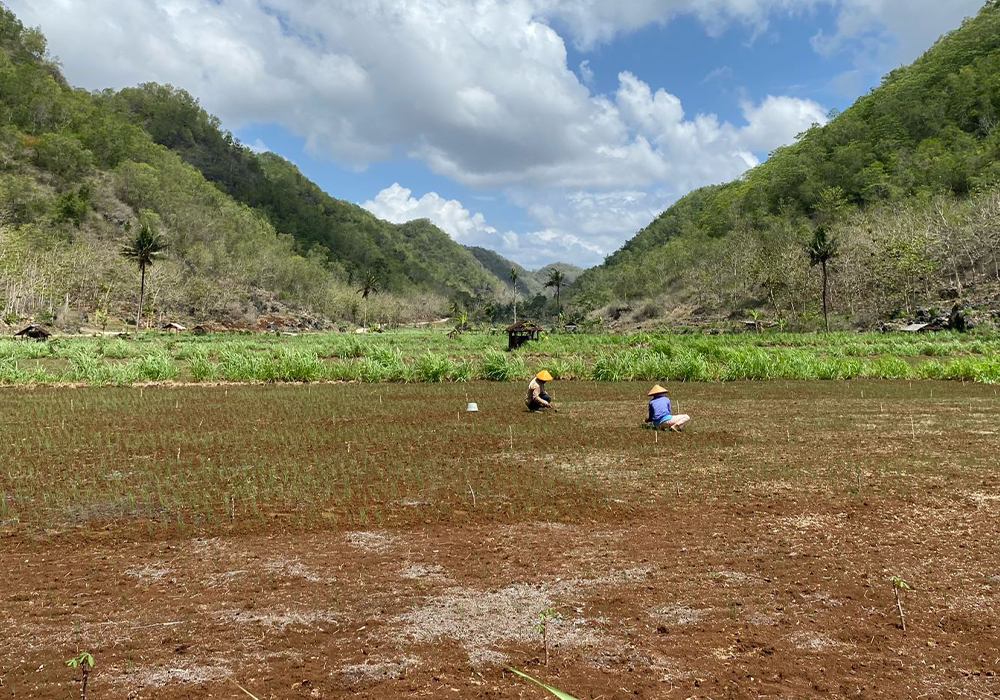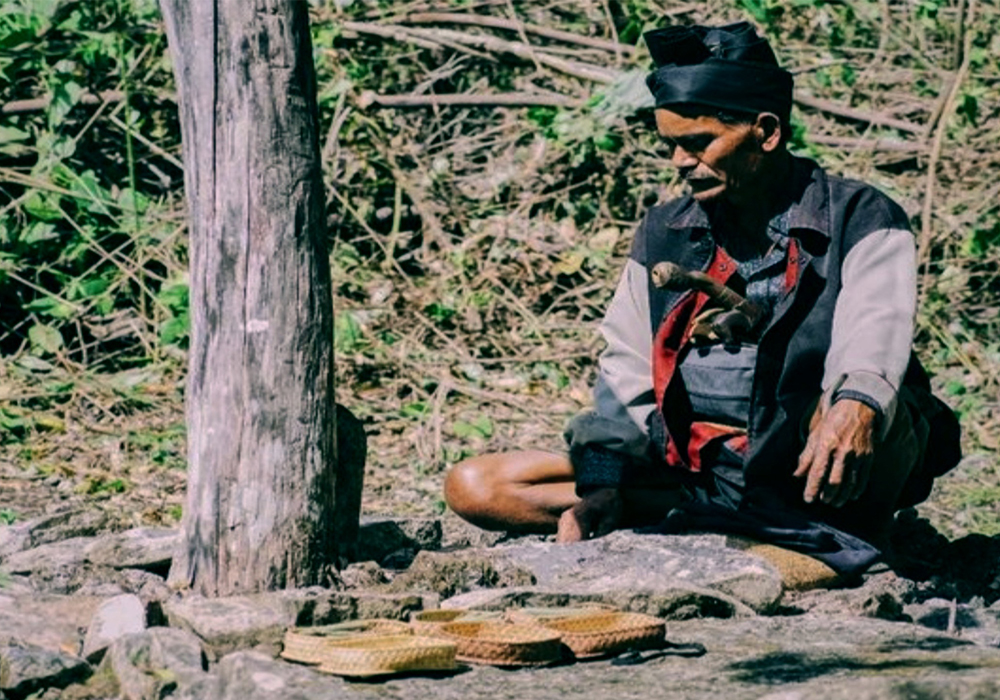
Two farmers were planting after experiencing 2-3 crop failures due to the dry season and relying on rain for irrigation. (Fariz Azhami Ahmad)
- admin
- 27 August 2024
- Feature
Lessons From the Field: Traditional Food Systems, Sustainable Futures
“Indigenous communities have the knowledge to manage natural resources both at sea and on land,” says Arif Satria, Chancellor of the Bogor Agricultural Institute (IPB), adding that these traditional food systems are “environmentally friendly, easily adaptable to weather changes and have high nutritional value.”
Speaking at a recent event titled ‘Youth Food Systems Dialogue and Movement 2023: Promoting Local Knowledge for Sustainable Food Systems in Indonesia’ initiated by CTSS IPB and supported by the Samdhana Institute, Satria highlighted the need to document local food knowledge and practices throughout Indonesia. Working together with civil society organizations, academics and students from universities in Bogor, Yogyakarta, Papua and East Sumba, IPB and Samdhana are gathering information through research on local food systems to address one of the most pressing issues of our time.
As the world continues to grapple with a worsening food crisis set in motion by modernization and exacerbated by climate change, Indigenous wisdom may provide the answer. In this article, we examine four localised traditional food systems operated by communities around Indonesia to assess their various merits and consider their potential for upscaling elsewhere. The following insights are the result of collaborative research and documentation alongside four Indigenous community groups in Indonesia.
Urug Village: Sustainable Communal Rice Production
For the people of Urug Village in the Sukajaya District of Bogor Regency, West Java, rice is sacred. Here, a series of ancestral customs and rituals guide every step of production, distribution and consumption to ensure rice remains sustainable.
“This Indigenous community still upholds ancestral values,” explains Muhamad Nur Afif, a student from IPB University who recently visited Urug Village, one of the research locations. “They pray to their ancestors to determine the right time to plant rice,” he added. After harvesting, seeds are set aside in a wooden building called a leuit for the next planting season.
By growing only what they need to feed themselves rather than squeezing the land for profit, the Indigenous People of Urug Village never exceed nature’s capacity to provide, while ensuring these resources can continue to feed them in the long term. Moreover, by being mindful of harvest times and turning to ancestral wisdom for guidance, they help to unite the community around common beliefs and ensure everyone gets a fair share.
Wotawati Village: Dealing with Drought
Wotawati Village in the Gunungkidul Regency of Yogyakarta often experiences droughts.
“When the dry season comes, the land here sags and cracks appear because it is so dry ," says Fariz Azhami Ahmad, a student at Gadjah Mada University who is conducting the research in the village alongside Critical Pedagogi Indonesia, an organization based in Yogyakarta.
In dealing with the water crisis, residents here have built rainwater collection tanks with a capacity of up to 6,000 litres each, and planted cassava, sweet potatoes and yam, as these are better suited to the climate and contours of the karst soil characteristic of Wotawati. Young people here have an important role to play in addressing these complex environmental and social issues, which demand an adaptive and innovative attitude. Together with universities, government agencies and NGOs, they are working to strengthen the local food system and diversify local foods so they are more adaptive to climate change.
Marapu: Sharing is Caring
Farmers in arid East Sumba use dry field farming techniques to plant rice, corn and soybeans, along with millet, sorghum, and local tubers such as littang, Iuwa, kabota and iwi. Traditional food systems operated by Indigenous communities here are rooted in three core concepts: mandara (sharing nature’s bounty), balang (preparing for the future), and uhu tangawatil (respecting ancestors).

“The purpose of food sharing, or mandara, is to exchange raw food materials," explains Ernalinda, a student from Wira Wacana Christian University in Sumba. She and another student, Neldi Tay Maranja, have been researching local wisdom in Sumba. She adds that these activities usually take place between communities living in markedly different environments, such as the mountains and coast, allowing them to access foods that would otherwise be unobtainable in their locality.
The practice of balang emphasises food storage to ensure availability for all villagers, while uhu tangawatil rituals are an expression of gratitude to nature, and a collective wish for bountiful harvests in future. In total, there are 13 rituals that must be carried out, conducted prior and during cultivation, at harvest time, storage and finally at the point of consumption. By sharing what they have with others, and ensuring the long-term sustainability of their produce, the Indigenous Peoples of East Sumba continue to respect nature while honouring their ancestors.
Women's Forest: Nature-based Solutions for Man-made Problems
For the women of Tobati Village in Papua’s Youtefa Bay, the local mangroves provide fish, shrimp and shellfish.
“This customary forest is very special,” explains Orpha Novita Yosua, a student at Cenderawasih University, “because women are given special space to conduct their activities,” she adds, noting that the region is actually referred to as ‘the Women's Forest.’
Although the forest was originally designated as a place for women’s work, such as foraging for shellfish, it has become something more significant. Often excluded from traditional decision-making processes, the women here have found a place to commune with nature and with each other, vent their frustrations and propose solutions to the problems they face.
One of the main issues they are up against is pollution. In recent years, local tourism developments have impacted environmental health in the bay, with a knock-on effect for the women who work here. “The quality and quantity of the mussels they find is dropping,” says Orpha. “There is a lot of plastic waste, which stops the flow of water and makes the mangroves into a swamp that’s riddled with mosquitoes.”
In response to these man-made problems, the Indigenous women of Tobati have turned to nature-based solutions, planting more mangroves to establish a buffer and replenish the forest. They are also advocating for the recognition of Indigenous Peoples’ rights as guardians of nature, the source of human life.
Their story, like those of many Indigenous communities from around Indonesia, demonstrates the importance of treading lightly on nature; of binding communities together by sharing resources, and working collaboratively to ensure we never take more than we need. By following their example, modern food systems can find solutions for a more sustainable future.